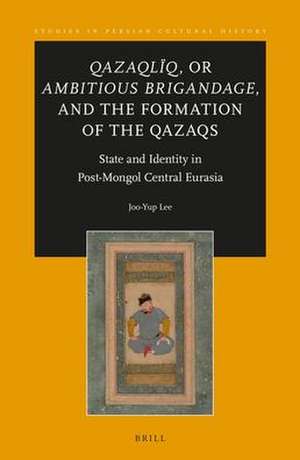<i>Qazaqlïq</i>, or <i>Ambitious Brigandage</i>, and the Formation of the Qazaqs: State and Identity in Post-Mongol Central Eurasia: Studies in Persian Cultural History, cartea 8
Autor Joo-Yup Leeen Limba Engleză Hardback – 3 dec 2015
Utilizing a broad range of original sources, the book suggests that the Qazaqs, as well as the Shibanid Uzbeks and Ukrainian Cossacks, came into existence as a result of the qazaq, or “ambitious brigand,” activities of their founders, providing a new paradigm for understanding state formation and identity in post-Mongol Central Eurasia.
Preț: 566.17 lei
Preț vechi: 690.45 lei
-18% Nou
Puncte Express: 849
Preț estimativ în valută:
108.34€ • 113.40$ • 90.17£
108.34€ • 113.40$ • 90.17£
Carte indisponibilă temporar
Doresc să fiu notificat când acest titlu va fi disponibil:
Se trimite...
Preluare comenzi: 021 569.72.76
Specificații
ISBN-13: 9789004306486
ISBN-10: 900430648X
Pagini: 238
Dimensiuni: 155 x 235 x 18 mm
Greutate: 0.48 kg
Editura: Brill
Colecția Brill
Seria Studies in Persian Cultural History
ISBN-10: 900430648X
Pagini: 238
Dimensiuni: 155 x 235 x 18 mm
Greutate: 0.48 kg
Editura: Brill
Colecția Brill
Seria Studies in Persian Cultural History
Notă biografică
Joo-Yup Lee, Ph.D. (2012) in Turko-Persian Studies, University of Toronto, is an independent scholar publishing and working on state formation and identity in post-Mongol Central Eurasia. He has lectured on the steppe frontier in Perso-Islamic and Eurasian history at the University of Toronto.
Recenzii
2017 CESS Book Award Winner
"The author has done a great service for historians of the Kazakhs, particularly those hoping
to introduce monolingual students to the rich sources for medieval Eastern Europe and Central
Asia. Those wishing to follow along with Lee’s analysis more closely are welcomed to do so by
the inclusion of two appendices marking the appearance and context of the terms qazaqlïq and
qazaq in medieval (Appendix 1) and modern sources (Appendix 2). The book also includes
several maps, though they are difficult to read as they contain only river courses, ethnic
labels, and the occasional city. Comprising the annotated bibliography in the introduction, a
bibliography, an index and two helpful family trees, the scholarly apparatus should be useful
to a wide array of scholars even tangentially interested in the field of Kazakh history."
Michael Hancock-Parmer, Indiana University Bloomington, USA, in Central Asian Review, 2016
"The author has done a great service for historians of the Kazakhs, particularly those hoping
to introduce monolingual students to the rich sources for medieval Eastern Europe and Central
Asia. Those wishing to follow along with Lee’s analysis more closely are welcomed to do so by
the inclusion of two appendices marking the appearance and context of the terms qazaqlïq and
qazaq in medieval (Appendix 1) and modern sources (Appendix 2). The book also includes
several maps, though they are difficult to read as they contain only river courses, ethnic
labels, and the occasional city. Comprising the annotated bibliography in the introduction, a
bibliography, an index and two helpful family trees, the scholarly apparatus should be useful
to a wide array of scholars even tangentially interested in the field of Kazakh history."
Michael Hancock-Parmer, Indiana University Bloomington, USA, in Central Asian Review, 2016












